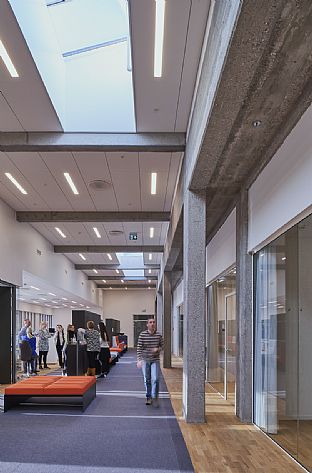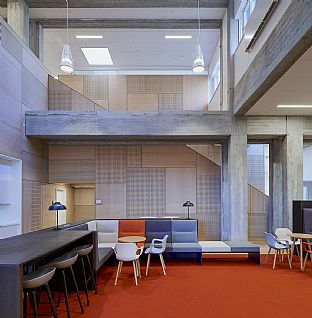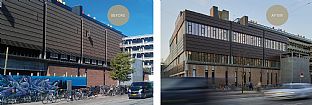
On the construction of the expansion of the Panum complex, the Mærsk Building, demolition of part of the existing Panum was necessary. This made it possible to convert a large part of the complex into a cohesive new office space for the Dean and Faculty administration, including the management secretariat, communication, finance and HR, etc., as well as workspaces for Panum operations staff. This was achieved by creating an open and transparent office environment with a high degree of flexibility.
Sky is the limit
This transformation has been achieved with great respect for the existing architecture. The original ceiling height has been re-created, the raw bearing columns are still apparent, and there are visible ceiling installations, while the original Panum colours are integrated in striking areas. The open-space offices are supplemented with good meeting facilities – as actual meeting rooms, partly open meeting spaces and open lounge areas.
"For the first time in many years, management and employees in the operations department are gathered in a shared area. Everyone is very enthusiastic about the functionality of the premises, the design, which creates new opportunities for cooperation and networking, and the very attractive architecture, which makes this a great place to work," says Marianne Vejen Hansen, user coordinator and project manager at the Faculty of Health and Medical Sciences of the University of Copenhagen.
A key aspect was to ensure that the new premises matched users' needs and requirements in terms of form and design, and also to create an identity in relation to the users' work tasks and roles. A targeted user process with a high level of involvement and a vision seminar for the entire operations department took place, so as to include and implement users' concrete needs and requirements. The open-plan office space is therefore designed with visible installations – ventilation pipes, cable trays, etc. and the existing Panum light fittings were reused and converted to LED light sources.
New openness
The conversions also made it possible to focus on a holistic solution for the re-creation and renovation of the building's façades, to bring plenty of daylight into the workspaces in the building, and also create a façade that was adapted to the building's architecture and original façade elements. For the east- and south-facing façades, the existing closed panel façades were adapted, adding recurring window bands with the same geometry and form as the rest of Panum. To ensure enough daylight for the office space here, the characteristic recurring slit windows are repeated in the solid brick base of the ground floor, while skylights break through the first floor to the ground floor, so that daylight can flow down through the building.
The handover was planned carefully to avoid "defective handover". As a consequence, the premises could be inaugurated immediately after handover, and the project has just been recommended for the 2016 Renover Prize.







